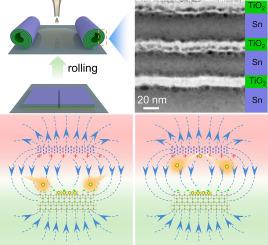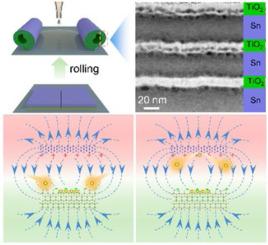-Sn/TiO2/Sn/TiO2-超晶格异质结的钠存储
IF 20.2
1区 材料科学
Q1 CHEMISTRY, PHYSICAL
引用次数: 0
摘要
异质结构电化学在高性能储能和转换器件的开发中起着重要的作用。然而,目前基于二维材料组装的超晶格异质结构仅限于少量交替单元,界面相互作用弱,功能机制不明确。本文采用应变释放法设计了具有内置电场的高阶-Sn/TiO2/Sn/TiO2- (S/TO)超晶格异质结。研究结果表明,这种周期性纳米结构电极具有良好的电化学性能,主要是由于其所容纳的电场和空间约束效应的共同作用。在TiO2板之间有效地限制了Sn的纳米化和粉碎空间,并且通过TiO2组分中的电子积累,协同加速了S/TO超晶格电极的钠储存和转移动力学,巧妙地减轻了电解质与TiO2表面区域之间的催化反应。共价Sn-O-Ti相互作用进一步增强了维持重复(去)调解过程的鲁棒性。这些发现为异质结构电化学开发高性能电极提供了一条有益的途径。本文章由计算机程序翻译,如有差异,请以英文原文为准。


Sodium storage of -Sn/TiO2/Sn/TiO2- Superlattice heterojunctions
Electrochemistry of heterostructures plays a fundamental role in developing high-performance energy storage and conversion devices. However, current superlattice heterostructures based on assembling 2D materials are limited to a small number of alternating units with weak interfacial interaction and ambiguous function mechanism. Herein, the high-order -Sn/TiO2/Sn/TiO2- (S/TO) superlattice heterojunctions with built-in electric fields (BIEFs) are designed for sodium storage using a strain release method. The results show that the accommodated BIEFs and the spatial confinement effect in this periodic nanostructured electrode co-contribute to the outstanding electrochemical performance. The nanosizing and pulverization of Sn are effectively space-limited in between the TiO2 slabs and the notorious catalytic reaction between electrolyte and TiO2 surface region is sophisticatedly mitigated by the electron accumulation in the TiO2 component, synergistically accelerating sodium storage and transfer kinetics of S/TO superlattice electrodes. The covalent Sn-O-Ti interactions further enhance the robustness to sustain repeated (de)sodiation processes. These findings provide a rewarding avenue towards the development of high-performance electrodes by heterostructural electrochemistry.
求助全文
通过发布文献求助,成功后即可免费获取论文全文。
去求助
来源期刊

Energy Storage Materials
Materials Science-General Materials Science
CiteScore
33.00
自引率
5.90%
发文量
652
审稿时长
27 days
期刊介绍:
Energy Storage Materials is a global interdisciplinary journal dedicated to sharing scientific and technological advancements in materials and devices for advanced energy storage and related energy conversion, such as in metal-O2 batteries. The journal features comprehensive research articles, including full papers and short communications, as well as authoritative feature articles and reviews by leading experts in the field.
Energy Storage Materials covers a wide range of topics, including the synthesis, fabrication, structure, properties, performance, and technological applications of energy storage materials. Additionally, the journal explores strategies, policies, and developments in the field of energy storage materials and devices for sustainable energy.
Published papers are selected based on their scientific and technological significance, their ability to provide valuable new knowledge, and their relevance to the international research community.
 求助内容:
求助内容: 应助结果提醒方式:
应助结果提醒方式:


